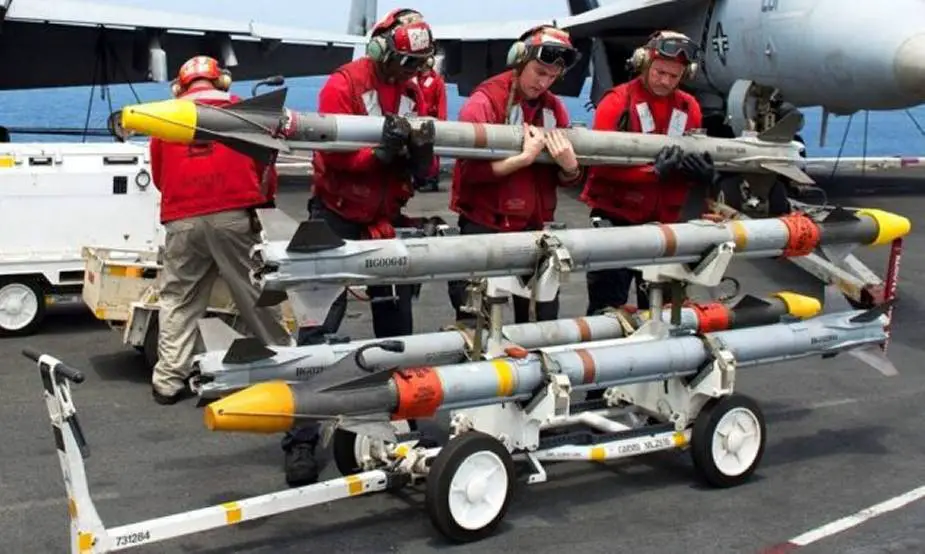Breaking news
Taiwan Air Force arming its F-16V fighters with new AIM-9X Block II air-to-air missiles.
As reported by RepublicWorld on May 22, Taiwan has bolstered its defense capabilities by arming its F-16s with new air-to-air missiles: the Republic Of China Air Force announced that the AIM-9X Block II Sidewinder missiles have been allocated to its F-16 Viper squadrons, which are deployed to respond to PLA’s increasing fly-bys.
Follow Air Recognition on Google News at this link
 AIM-9X Sidewinder air-to-air missiles to be loaded on US. Navy fighters (Picture source: U.S. Navy)
AIM-9X Sidewinder air-to-air missiles to be loaded on US. Navy fighters (Picture source: U.S. Navy)
In accordance with the scheduled plan, the AIM-9X Block II missiles have been successfully installed on Taiwan's 64 F-16Vs at the 4th Tactical Fighter Wing in Chiayi, as confirmed by an air force spokesperson mentioned in a South China Morning Post report. This installation aligns with the air force's combat readiness regulations, which require all standby aircraft monitoring PLA warplanes to be armed with weapons. By incorporating the AIM-9X Block II missiles, the F-16Vs in Taiwan's fleet at the 4th Tactical Fighter Wing in Chiayi have significantly improved their tracking and precision-strike capabilities.
Moreover, an undisclosed source within the air force disclosed that alongside the AIM-9X missiles, one side of the fighter jets has been equipped with an AIM-120 advanced medium-range air-to-air missile. The retrofitting of AIM-9X missiles is also currently in progress for the F-16Vs stationed at the 5th Tactical Fighter Wing in Hualien, which is located on the eastern side of the island.
The AIM-9X missiles garnered attention earlier this year when the United States employed them to intercept an alleged Chinese spy balloon within its airspace. In 2016, Taiwan procured 140 AIM-9X Block II missiles from the US as part of a collaborative upgrade program with defense contractor Lockheed Martin, aimed at enhancing the capabilities of its 141 F-16A/B versions.
The conversion process for the fighter jets is anticipated to conclude by the end of this year. Presently, it has been reported that the F-16 squadrons in Hualien have received over 40 of these upgraded jets. In 2019, the United States approved the sale of an additional 66 F-16Vs to Taiwan, with delivery scheduled for 2026.
AIM-9X Block II
Testing work on the AIM-9X Block II version began in September 2008. Block II adds lock-on after-launch capability with a datalink, so the missile can be launched first and then directed to its target afterward by an aircraft with the proper equipment for 360-degree engagements, such as the F-35 or the F-22. By January 2013, the AIM-9X Block II was about halfway through its operational testing and performing better than expected. NAVAIR reported that the missile was exceeding performance requirements in all areas, including lock-on after launch (LOAL).
One area where Block II needs improvement is helmetless high off-boresight (HHOBS) performance. It is functioning well on the missile, but its performance is below that of the Block I AIM-9X. The HHOBS deficiency does not impact any other Block II capabilities and is planned to be improved upon by a software clean-up build. Objectives of the operational test were due to be completed by the third quarter of 2013. On 18 June 2017, after an AIM-9X did not successfully track a targeted Syrian Air Force Su-22 Fitter, US Navy Lt. Cmdr. Michael “Mob” Tremel flying a F/A-18E Super Hornet used an AMRAAM AAM to successfully destroy the enemy aircraft.
In February 2015, the U.S. Army successfully launched an AIM-9X Block II from the new Multi-Mission Launcher (MML), a truck-mounted missile launch container that can hold 15 missiles. The MML is part of the Indirect Fire Protection Capability Increment 2-Intercept (IFPC Inc. 2-I) to protect ground forces against cruise missile and unmanned aerial vehicle threats. The AIM-9X Block II has been determined by the Army to be the best solution to cruise missile and UAV threats because of its passive imaging infrared seeker. The MML complements the AN/TWQ-1 Avenger air defense system.



















